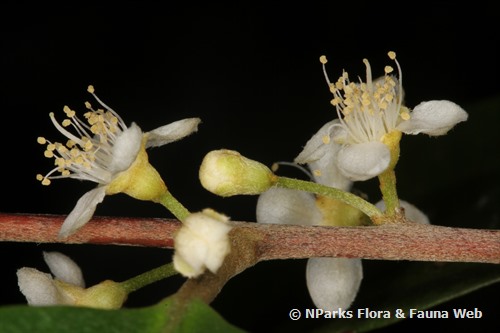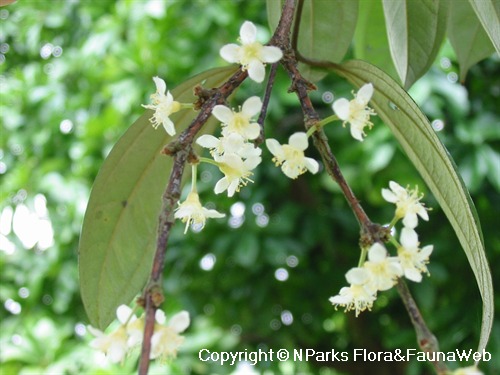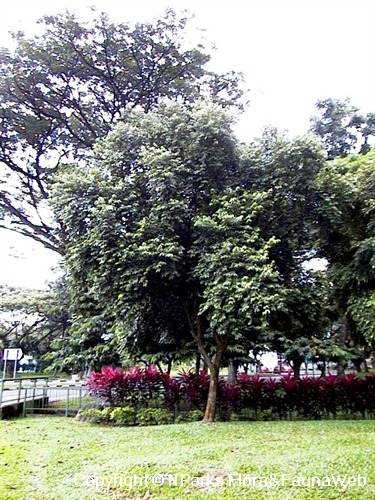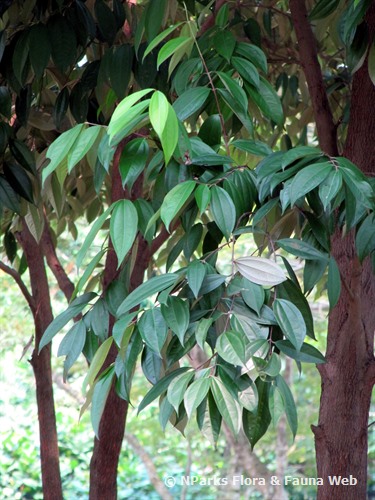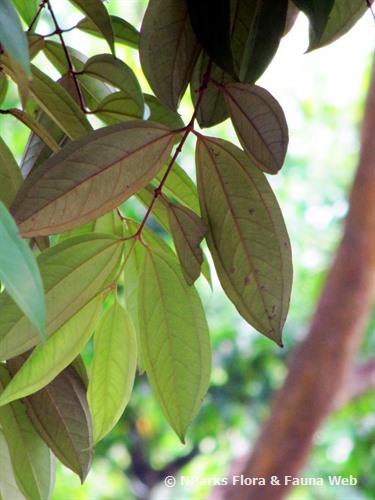_lowres.jpg)
Back
Rhodamnia cinerea Jack
| Family Name: | Myrtaceae |
| Synonyms: | Monoxora spectabilis (Blume) Wight, Myrtus globosa Korth., Myrtus smilacifolia Wall., Rhodamnia concolor (Blume) Miq., Rhodamnia spectabilis (Blume) Blume, Rhodamnia subtriflora Blume, Rhodamnia trinervia auct. pro parte, Rhodamnia cinerea var. caudata Ridl. |
| Common Name: | Silver Back Tree, Mempoyan, Poyan, Empoyan, Mengkoyan, Tempoyan, Lidah Katak Bukit |
Rhodamnia cinerea, also known as Silver Back Tree, is a native tree in Singapore. It can reach up to 20 m tall and the leaves have characteristically silvery or grey undersides owing to the minute silky hairs. The wood is used to make firewood, good quality charcoal and for constructing houses.
Name
Classifications and Characteristics
| Plant Division | Angiosperms (Flowering Seed Plants) (Dicotyledon) |
|---|---|
| Plant Growth Form | Tree |
| Lifespan (in Singapore) | Perennial |
| Mode of Nutrition | Autotrophic |
| Plant Shape | Rounded |
| Maximum Height | 20 m |
Biogeography
| Native Distribution | Myanmar, Thailand, Peninsular Malaysia, Sumatra, Java and Borneo |
|---|---|
| Native Habitat | Terrestrial (Secondary Rainforest) |
| Preferred Climate Zone | Tropical, Sub-Tropical / Monsoonal |
| Local Conservation Status | Native to Singapore (Least Concern (LC)) |
Description and Ethnobotany
| Growth Form | It is a tree, up to 20 m tall with mauve-brown smooth bark. |
|---|---|
| Foliage | Leaves are thin and in opposite arrangement. Each leaf is wedge-shaped (7 – 20 cm long and 2 – 6 cm wide). The leaf has 3 distinct longitudinal veins, and characteristically silvery or grey undersides owing to the minute silky hairs. In some individuals, the leaf blades are green below. The leaf stalk is about 0.7 cm long. |
| Flowers | Flowers are bisexual and occur as clusters of up to 6 at each leaf axils (dichasial). Each flower is small (about 1 cm wide) and comprises of 4 white petals and numerous stamens. It also has hemispherical calyx lobes and a cup-shaped hypanthium (floral receptacle). |
| Fruit | Fruit is round and berry-like (up to 0.8 cm diameter). It turns from green to red, then purple and finally black when ripe. The top of the fruit is crowned by remnants of the sepals. Each fruit contains 4 – 10 (- 25) angular seeds. The seeds are hard and are embedded in the fleshy fruit pulp. |
| Habitat | It is found in secondary forest, on infertile or degraded soil, up to 1000m altitude. |
| Associated Fauna | Its flowers attract many bees. Its seeds are dispersed by bats, birds, squirrels, and monkeys. |
| Cultivation | It can be propagated by seeds, cuttings, and air-layering. |
| Etymology | Greek rhodon, means red; Greek amnion, means the foetal membrane in mammals. The genus epithet Rhodamnia refers to the viscous fluid around the ovules. Latin cinereus, grey-coloured, referring to the colour of the underside of the leaf blade |
| Ethnobotanical Uses | Edible Plant Parts : Edible Fruits Food (Fruit or Vegetable): The fresh fruit is edible but astringent. Medicinal: Traditional Medicinal Uses In Southeast Asia, a poultice of the shoots is used in traditional medicine to treat burn wounds. In Myanmar and Thailand, a decoction of the fruit is also traditionally used to treat ulcers and bleeding gums (Gardner et al. 2018) It is important to note that some therapeutic effects from traditional medicinal uses of plants are not currently supported or verified by scientific research. Timber & Products: The wood is hard and durable. It is used to make firewood, good quality charcoal and also used to build houses and fence posts. The branches are reportedly good for the cultivation of epiphytic orchids. Others: The bark contains tanning which is used as a black dye and also to strengthen fishing nets. |
Landscaping Features
| Landscaping | It is suitable for parks and streetscapes. |
|---|---|
| Desirable Plant Features | Ornamental Foliage, Ornamental Flowers |
| Landscape Uses | General, Suitable for Roadsides, Parks & Gardens, Reforestation |
Fauna, Pollination and Dispersal
| Fauna Pollination Dispersal Associated Fauna | Bird-Attracting (Fruits), Bat Food (Fruits) |
|---|---|
| Pollination Method(s) | Biotic (Fauna) |
| Seed or Spore Dispersal | Biotic (Fauna) |
Plant Care and Propagation
| Light Preference | Full Sun |
|---|---|
| Water Preference | Moderate Water |
| Plant Growth Rate | Fast to Moderate |
| Rootzone Tolerance | Moist Soils, Well-Drained Soils, Poor Infertile Soils, Fertile Loamy Soils |
| Propagation Method | Seed, Stem Cutting |
Foliar
| Foliage Retention | Evergreen |
|---|---|
| Mature Foliage Colour(s) | Green, Silver / Grey |
| Mature Foliage Texture(s) | Thin |
| Prominent Young Flush Colour(s) | Silver / Grey |
| Foliar Type | Simple / Unifoliate |
| Foliar Arrangement Along Stem | Opposite |
| Foliar Attachment to Stem | Petiolate |
| Foliar Shape(s) | Non-Palm Foliage (Elliptical, Lanceolate) |
| Foliar Venation | Pinnate / Net, Parallel |
| Foliar Margin | Entire |
| Foliar Apex - Tip | Acuminate |
| Leaf Area Index (LAI) for Green Plot Ratio | 4.0 (Tree - Dense Canopy) |
Non - Foliar and Storage
| Trunk Type (Non Palm) | Woody |
|---|---|
| Mature Bark Texture | Smooth |
| Root Type | Underground |
Floral (Angiosperm)
| Flower & Plant Sexuality | Bisexual Flowers |
| Flower Colour(s) | White |
|---|---|
| Flower Grouping | Cluster / Inflorescence |
| Flower Location | Axillary |
| Flower Symmetry | Radial |
| Flowering Period | A Few Times Yearly |
| Flowering Opening Time | Daytime |
| Flowering Habit | Polycarpic |
Fruit, Seed and Spore
| Mature Fruit Colour(s) | Black |
|---|---|
| Fruit Classification | Simple Fruit |
| Fruit Type | Fleshy Fruit , Non-Accessory Fruit |
| Seed Quantity Per Fruit | Moderate (6-10) |
References
| References | Ashton, P.S. (2011). Myrtaceae s.l. In: Soepadmo, E., Saw, L.G., Chung, R.C.K. & Kiew, R. (eds) Tree Flora of Sabah and Sarawak 7: 87–330. Malaysia: Sabah Forestry Department, Forest Research Institute Malaysia (FRIM), Sarawak Forestry Department. Gardner, S., Sidisunthorn, P., & Chayamarit, K. (2018). Forest Trees of Southern Thailand. Volume 3 (Mo – Z). The Forest Herbarium, Bangkok, The Royal Botanic Gardens, Kew. Pp. 1532−2401. Bangkok: Amarin Printing and Publishing Plc. Keng, H. (1990). The Concise Flora of Singapore: Gymnosperms and Dicotyledons. Singapore: Singapore University Press. Parnell, J.A.N., & Chantaranothai, P. (2002). Myrtaceae. In: Larsen, K. & Santisuk, T. (eds.) Flora of Thailand, vol. 7 (4), pp. 778–914. Bangkok: Prachachon Co. Ltd. |
|---|
Image Repository
Others
| Master ID | 1809 |
|---|---|
| Species ID | 3102 |
| Flora Disclaimer | The information in this website has been compiled from reliable sources, such as reference works on medicinal plants. It is not a substitute for medical advice or treatment and NParks does not purport to provide any medical advice. Readers should always consult his/her physician before using or consuming a plant for medicinal purposes. |

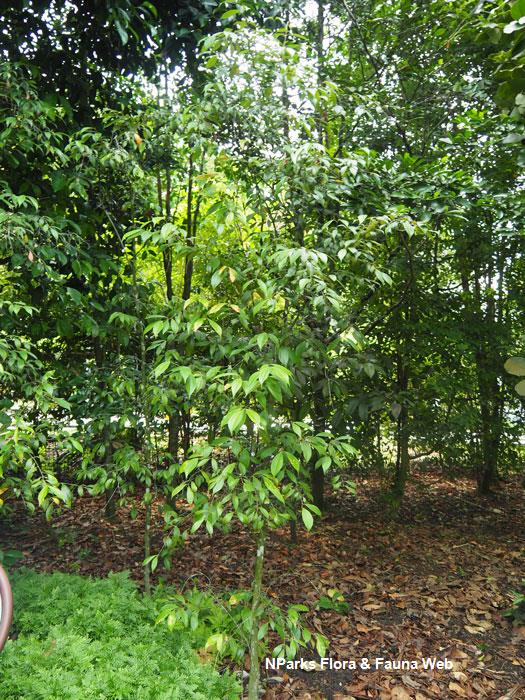
_lowres.jpg)

_lowres.jpg)
_lowres.jpg)
